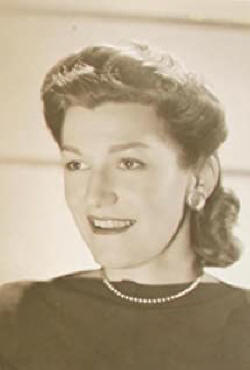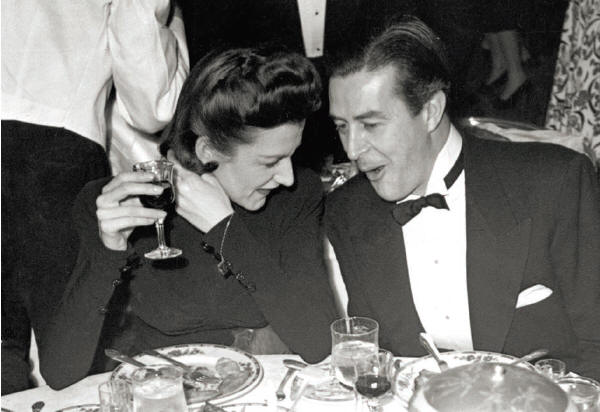

Queer Places:
MPT Country House, 23388 Mulholland Dr, Woodland Hills, CA 91364
 Natalie Visart (April 14, 1910 – September 11, 1986) was an American costume designer.
Natalie Visart (April 14, 1910 – September 11, 1986) was an American costume designer.
Visart had been born Natalie Visart Schenkelberger in Chicago on April 14, 1910. Her father, Peter C. Schenkelberger, a tall, bald man with a withered left leg, was a surgeon; and her mother, Marie Gertrude Debury, was a Canadian immigrant. Visart expected to follow her father in a medical career as a nurse. But in September of 1920, her respiratory health issues prompted her father to send Visart to live in California. She met Katharine DeMille at the Hollywood School for Girls. The DeMille family befriended Visart, inviting her to spend weekends and school vacations with them.
In 1927, Mitchell Leisen married opera singer Stella Seager, known professionally as Sandra Gahle, in a ceremony at DeMille’s ranch. Although they would remain married for fifteen years, their marriage was anything but traditional. The two lived apart frequently. Gahle even lived in France for a few years studying voice. Leisen had numerous dalliances, which Gahle knew about, and did not seem to mind. Some lovers were men. Others were women. And one was Visart. The two met at DeMille’s house during the time Leisen was collaborating with the director on The Volga Boatman (1926), and Visart was hanging out with the director’s daughter after school.
In the mid-1930s, according to his lesbian secretary Eleanor Broder, Leisen began taking hormone shots in the hopes they might "cure" his homosexuality. He also began living with Natalie Visart, who later miscarried his child. Visart was undoubtedly fl attered to receive the attention of a successful older man, at least initially. Ultimately their connection was as much cerebral as physical, according to Visart’s daughter, Laurel Taylor. The two “got” each other, she said. And Leisen proved helpful to Visart’s career. As he began working as a director in 1933, he positioned Visart to take his place as DeMille’s costume designer. By 1936, she was assigned to costume The Plainsman.

Natalie Visart and Ray Milland
Natalie Visart had a brief career in film, collaborating as a costume designer on only eleven American films. The first is the western An Adventure of Buffalo Bill (starring Gary Cooper and Jean Arthur), released in 1936 and directed by Cecil B. DeMille. Having already participated in his first film as an actress (a small uncredited role in Madame Satan in 1930, experience not renewed), she found him for five others, including The Shipwreckers of the South Seas (1942, with Paulette Goddard and Ray Milland). The last is The Odyssey of Doctor Wassell (1944, with Gary Cooper and Laraine Day). Other directors she assisted included Frank Capra (The Man in the Street in 1941, with Gary Cooper and Barbara Stanwyck) and William A. Wellman (The Strangler in 1943, with Barbara Stanwyck and Michael O'Shea). Her final two films were released in 1946, including Edgar G. Ulmer's The Demon of the Flesh (starring Hedy Lamarr and George Sanders).
Despite his marriage to Gahle, Leisen openly lived with Visart during the 1930s. He also carried on with his fl ying instructor, Edward Anderson. Leisen eventually made Anderson an assistant director on The Big Broadcast of 1938. Because the two men had an outwardly plausible non-sexual pretext for their rendezvous, appearance-conscious Visart tolerated the affair, which did not last. During production of Big Broadcast, Anderson’s affections turned from Leisen to leading lady Shirley Ross. When the loss of Anderson to Ross seemed inevitable, Leisen began pursuing dancer and choreographer Billy Daniel.
The upheaval in Leisen’s personal life took a toll on him. On the last night of shooting Big Broadcast, Leisen suffered a serious heart attack. His subsequent recovery changed him. He became cranky. And he no longer showed any discretion regarding his libido. While Visart could adjust to Leisen’s cantankerous personality shift, she could not abide him flaunting his relationship with Daniel. She left Hollywood to work for milliner Lily Dache in Paris, even though her career as DeMille’s costume designer had just started to take off. Visart was not gone from Hollywood long though. As the Nazis menaced Europe, she returned to Los Angeles, where DeMille welcomed her back by hiring her to design the wardrobe for North West Mounted Police (1940). The war in Europe also prompted Gahle to return to the United States, settling in San Francisco, where she performed with the local opera.
Despite her misgivings, Visart resumed her affair with Leisen. He induced Barbara Stanwyck to hire her for Meet John Doe (1941), a collaboration that resulted in some of Visart’s best work. More than fifty years later, Visart’s white outfit which Stanwyck wears as her character reveals that she is in love with Gary Cooper still drew accolades for its story-telling power. Stanwyck’s character “sold out so hard, so fast, so elegantly, and it’s all expressed in that costume,” director Michael Tolan said in 1995. “Everyone wants costume to express character transformation. That’s almost too extreme a transformation, but it works because she looks so great.” After Meet John Doe, DeMille induced Paramount to offer Visart a contract, but she declined, telling DeMille that she was afraid that during downtime “Edith Head would have me picking up pins off the workroom fl oor.” She decided to sign with producer Hunt Stromberg instead.
In late 1942, Visart found herself in the same difficult position Loretta Young had been in 1935, when she conceived Clark Gable’s child on the set of The Call of the Wild (1935). Visart, who had worked on The Crusades with Young, now found herself carrying Leisen’s child. Because Young had worn loose-flowing costumes in the medieval drama, made right after Call of the Wild, no one realized she was pregnant. “Natalie was one of the people in on the fact then that Loretta had adopted her own daughter,” film historian David Chierichetti said. “So when Natalie got pregnant, it occurred to her and Mitchell that they would do the same thing.” Visart would have probably preferred to marry Leisen, but she could not. Although Gahle moved to Idaho in 1942, specifically to establish residency to sue Leisen for divorce, he would not be single again until after the child’s birth. Even then, because Visart was a devout Catholic, she would not be able to marry Leisen as a divorced man until the Vatican annulled his marriage to Gahle. These issues became moot when Visart miscarried. In a cruel twist of irony, soon after the miscarriage Paramount sent Leisen the script of To Each His Own (1946), which recounts the story of a woman who adopts her own child. He turned it down initially, saying that it was too close to Madame X (1937), but in reality, it was too close to his own life. Leisen did eventually direct To Each His Own, for which Olivia de Havilland won an Oscar for Best Actress.
On March 30, 1946, Visart married writer Dwight Bixby Taylor, soon after meeting him at a party. He was one of the first “Talk of the Town” editors for The New Yorker and later a noted novelist, playwright, and screenwriter. Taylor was himself the child of famous parents, actress Laurette Taylor and producer Charles Taylor.
Visart and Leisen stayed in touch through the decades to come. In 1951, Eleanor Broder and Natalie Taylor had an extended vacation in one of the Club Cottages in Palm Springs following the completion of Leisen’s last picture, “Young Man In a Hurry.”
She died on September 11, 1986 in Los Angeles, California, USA.
On December 31, 1986, one day before his 84th birthday, Dwight Taylor died of a heart attack at the Motion Picture and Television Hospital in Woodland Hills, California where he had resided since 1981, thus achieving a rare feat of being born on New Year's Day and dying on New Year's Eve. He had been widowed three months earlier by his second wife, Natalie Visart. His first wife was Marigold Lockhart Langworthy (1901–1951), whom he married on May 25, 1929, and by whom he had three children (Andrew, Audrey, and Jeffrey).
My published books: